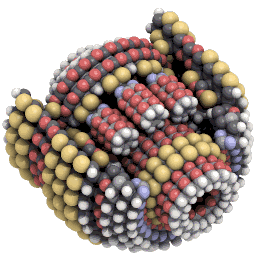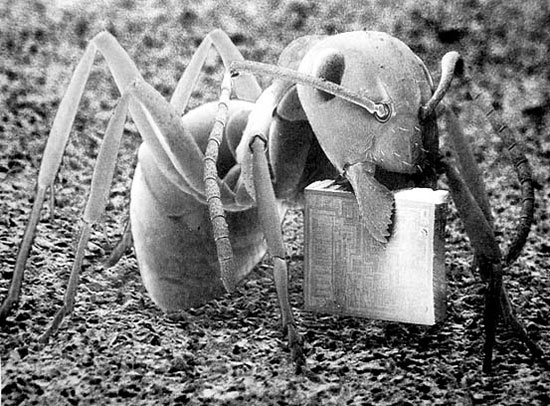
Industry News
500 nm the wavelength of visible light. A microscope is LIMITED TO
this size. It cannot see anything smaller.
To see anything smaller than 500 nm, needs an electron microscope, or
better yet a Scanning tunneling microscope.
0.1 mm The smallest objects that the unaided human eye can see
The power of a light microscope is limited by , which is about . The
most powerful light microscopes can resolve bacteria but not viruses.
AFM (Atomic force microscope)
STM (Scanning tunneling microscope)
SEM (scanning electron microscope)
One nanometer (nm) is one billionth, or 10-9, of a meter.
.12–0.15 nm carbon-carbon bond lengths, or the spacing between these
atoms in a molecule
.25 nm: Hydrogen, the smallest atom diameter
2 nm: DNA's double-helix diameter
200 nm: The length of the smallest cellular life-form, the bacteria of
the genus Mycoplasma
0.1 nm (nanometer) diameter of a hydrogen atom
0.8 nm Amino Acid
2 nm Diameter of a DNA Alpha helix
4 nm Globular Protein
6 nm microfilaments
7 nm thickness cell membranes
20 nm Ribosome
25 nm Microtubule
30 nm Small virus (Picornaviruses)
50 nm Nuclear pore
100 nm HIV
120 nm Large virus (Orthomyxoviruses, includes influenza virus)
150-250 nm Very large virus (Rhabdoviruses, Paramyxoviruses)
150-250 nm small bacteria such as Mycoplasma
200 nm Centriole
200 nm (200 to 500 nm) Lysosomes
200 nm (200 to 500 nm) Peroxisomes
800 nm giant virus Mimivirus
1000 nm = 1 µm (micrometer)
1 µm Diameter of human nerve cell process
2 µm E.coli - a bacterium
3 µm Mitochondrion
5 µm length of chloroplast
6 µm (3 - 10 micrometers) the Nucleus
9 µm Human red blood cell
10 µm
(10 - 30 µm) Most Eukaryotic animal cells
(10 - 100 µm) Most Eukaryotic plant cells
90 µm small Amoeba
100 µm Human Egg
up to 500 µm giant bacterium Thiomargarita
up to 800 µm large Amoeba
http://en.wikibooks.org/wiki/Cell_Biology/Introduction/Cell_size
Scientists usually describe the length of DNA using a unit called kb or kbp. One kb is 1000 base pairs, the base pair being the basic
repeating nucleotide unit of the DNA chain. Each base pair has a length of 0.33 nm.
Plasmid DNA might have a length of 1-200 kb, or 0.33 nm to 66 nm.
Bacterial chromosomal DNA length would be perhaps 3800 kb, or 1300 nm (1.3 microns).
The length of human chromosome number 1 DNA is 200,000 kb, or 67,000 nm (67 microns).
3,000,000,000nm (3.0 m) A Human cell's DNA totals about 3 meters in length. (Totaling base pairs (bp) of DNA in 46 chromosomes (22 autosome pairs + 2 sex chromosomes)
http://hypertextbook.com/facts/1998/StevenChen.shtml
AFM has several advantages over the scanning electron microscope (SEM). Unlike the electron microscope which provides a two-dimensional projection or a two-dimensional image of a sample, the AFM provides a three-dimensional surface profile. Additionally, samples viewed by AFM do not require any special treatments (such as metal/carbon coatings) that would irreversibly change or damage the sample, and does not typically suffer from charging artifacts in the final image. While an electron microscope needs an expensive vacuum environment for proper operation, most AFM modes can work perfectly well in ambient air or even a liquid environment. This makes it possible to study biological macromolecules and even living organisms. In principle, AFM can
provide higher resolution than SEM. It has been shown to give true atomic resolution in ultra-high vacuum (UHV) and, more recently, in liquid environments. High resolution AFM is comparable in resolution to scanning tunneling microscopy and transmission electron microscopy. AFM can also be combined with a variety of optical microscopy techniques, further expanding its applicability. Combined AFM-optical instruments have been applied primarily in the biological sciences but has also found a niche in some materials applications, especially those involving photovoltaics research.
Disadvantages
A disadvantage of AFM compared with the (SEM) scanning electron microscope is the single scan image size. In one pass, the SEM can image an area on the order of square millimeters with a depth of field on the order of millimeters, whereas the AFM can only image a maximum height on the order of 10-20 micrometers and a maximum scanning area of about 150×150 micrometers. One method of improving the scanned area size for AFM is by using parallel probes in a fashion similar to that of millipede data storage.
The scanning speed of an AFM is also a limitation. Traditionally, an AFM cannot scan images as fast as a SEM, requiring several minutes for a typical scan, while a SEM is capable of scanning at near real-time, although at relatively low quality. The relatively slow rate of scanning during AFM imaging often leads to thermal drift in the image making the AFM microscope less suited for measuring accurate distances between topographical features on the image.
However, several fast-acting designs were suggested to increase microscope scanning productivity including what is being
termed videoAFM (reasonable quality images are being obtained with videoAFM at video rate: faster than the average SEM). To eliminate image distortions induced by thermal drift, several methods have been introduced.
Create your own web pages in minutes...
MentorsAcrossAmerica.com Cincinnati, OH (513) 436-4724


.jpg)
